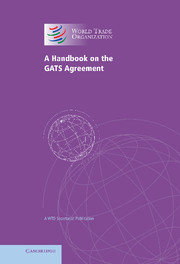Book contents
- Frontmatter
- Contents
- Preface
- Introduction
- 1 Basic purpose and concepts
- 2 Main building blocks: agreement, annexes and schedules
- 3 A closer look at domestic regulation
- 4 How the GATS is administered
- 5 The role and responsibilities of Member governments
- 6 The challenges ahead
- 7 Preparing requests and offers
- 8 Misconceptions about the GATS
- Appendix 1 Understanding your country's services trade
- Appendix 2 Relevant services statistics and classifications
- Annex: General Agreement on Trade in Services
- Index
5 - The role and responsibilities of Member governments
Published online by Cambridge University Press: 07 October 2011
- Frontmatter
- Contents
- Preface
- Introduction
- 1 Basic purpose and concepts
- 2 Main building blocks: agreement, annexes and schedules
- 3 A closer look at domestic regulation
- 4 How the GATS is administered
- 5 The role and responsibilities of Member governments
- 6 The challenges ahead
- 7 Preparing requests and offers
- 8 Misconceptions about the GATS
- Appendix 1 Understanding your country's services trade
- Appendix 2 Relevant services statistics and classifications
- Annex: General Agreement on Trade in Services
- Index
Summary
THE MINISTRIES AND AGENCIES INVOLVED
The GATS is a relatively new agreement. National administrations thus have less experience in dealing with GATS-related issues than with “traditional” trade problems under the GATT, and they do not normally have a central structure for co-ordinating their services-related policies. A wide range of ministries and agencies at various government levels may be involved.
Regulation of services often occurs in fact at sub-federal levels (state/province/municipality or parish) or, in some instances (e.g., professional licensing), has been delegated to private-sector organizations. A related challenge is the fact that there are some 160 service sub-sectors involved, which would be difficult for any central agency to oversee. In order to ensure compliance with existing obligations, and to participate effectively in the new round, national administrations may find it useful to create sector- or issue-related working groups. Table 2 suggests how such groups might be composed.
Given the regulatory intensity of many service activities and the range of sectors involved, proper co-ordination and information across agencies and government levels is critical for at least three purposes:
(i) ensuring awareness of the types of GATS-related measures falling under a ministry's or agency's jurisdiction;
(ii) ensuring that each ministry/agency has properly identified and analyzed – against the background of existing GATS obligations, including specific commitments – its current use of measures; and
(iii) ensuring that, in preparing new measures, relevant GATS obligations – including notification requirements – are taken into account and complied with.
As noted before, apart from specific commitments, there are in principle two types of legal obligations under the Agreement: unconditional obligations that apply across all services covered by the GATS, and conditional obligations that apply only to sectors where specific commitments have been made.
- Type
- Chapter
- Information
- A Handbook on the GATS AgreementA WTO Secretariat Publication, pp. 30 - 34Publisher: Cambridge University PressPrint publication year: 2005

